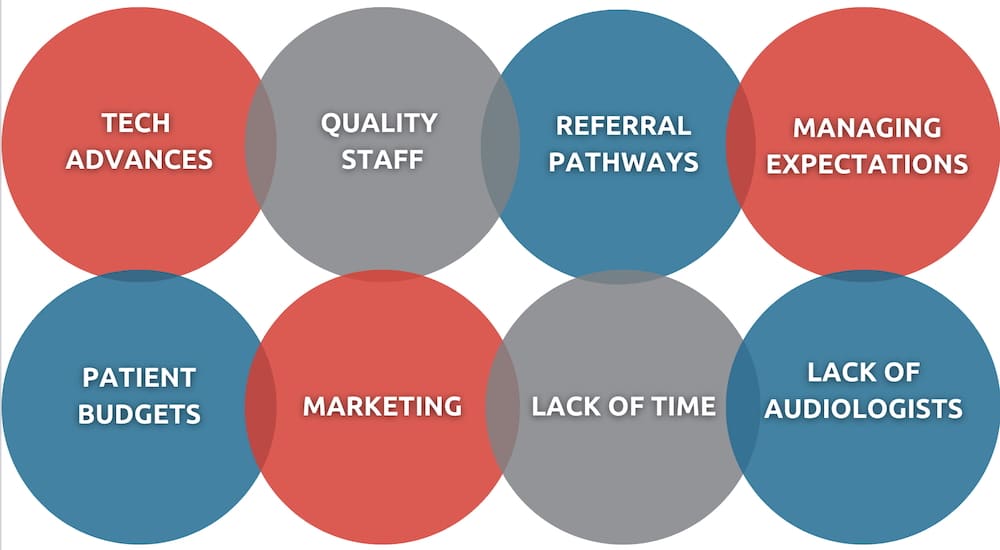Compression factors: a balancing act - advice From the Oval Window
Advancements in hearing technology have revolutionised the way individuals with hearing loss experience the world around them. Modern hearing aids and cochlear implants have significantly improved the quality of life for millions of people. But the process of programming these devices to meet the unique needs of each patient remains a complex and challenging task.

Hearing impairment is a highly individualised condition, with diverse causes, levels, and patterns. Programming hearing technology requires a thorough understanding of a patient’s specific hearing profile and the pure tone audiogram is only part of the picture professionals need to be aware of for successful treatments.
The challenges of our differences: ageing, lifestyle, ambiences,…
Hearing is a subjective experience, and each person perceives sound differently. Factors such as age, cognitive abilities, and previous experience with sound shape how an individual hears and processes auditory information. Furthermore, the diverse real-world sound environments they encounter daily vary tremendously from person to person and they must adjust to the rapidly changing dynamic listening challenges.
Their unique lifestyle also influences their hearing needs and preferences. Therefore, the combination of individualised demands/requirements combined with an ever-evolving philosophy of the hearing technology manufacturing world makes it increasingly more challenging for the hearing care practitioner to get it right. And I mean not just satisfying the subjective need of the patient but ensuring and validating that you are providing them with the best available outcome.
Referring back to the headline lead, optimising compression settings in hearing technology in general, but particularly for individuals suffering from cognitive decline or other forms of auditory processing capabilities, is a challenging task that requires striking a delicate balance between standardisation and personalisation.
By incorporating validated prescriptive gain formulae and taking into consideration the individual’s binaural broadband summation employing trueLOUDNESS fitting, it appears that clinicians can offer a comprehensive approach to address the unique needs of the most challenging cases. There is an argument for utilising these methodologies that highlights their potential in enhancing audibility, speech intelligibility, and overall listening comfort.
By finding the right balance between standardised guidelines, individual loudness perception, and binaural benefits, practitioners can optimise compression settings to a permissible degree (limitations set by hearing instruments manufacturers’ products and own philosophy), to improve communication abilities and quality of life for individuals with challenging auditory processing capabilities and/or cognitive decline.
The role of prescriptive gain formulae
Prescriptive gain formulae play a crucial role in determining appropriate amplification levels for individuals with hearing loss, including those with challenging auditory processing capabilities, although these are not taken into consideration in the formulae. These formulae provide standardised guidelines based on the degree and configuration of hearing loss, ensuring consistent amplification across different practitioners. Research has consistently shown that utilising prescriptive gain formulae significantly improves speech recognition performance and listening comfort for individuals with hearing loss.
Prescriptive gain formulae offer several benefits. They provide a reliable foundation for fine-tuning or personalising hearing technology settings, and streamline the fitting process, promoting consistency and efficiency. By incorporating evidence-based guidelines, practitioners can establish appropriate compression levels that optimise speech understanding for individuals.
 The Power of trueLOUDNESS Fitting
The Power of trueLOUDNESS Fitting
TrueLOUDNESS fitting is an emerging methodology that addresses individual loudness perception in hearing technology fittings. It takes into account an individual’s subjective loudness growth across different input levels, enabling personalised amplification based on their unique loudness preferences (see THE BINAURAL BROADBAND LOUDNESS SUMMATION – Why does the pure-tone audiogram explain only 30% of a hearing loss? – Audiology Worldnews – by Dr. Dirk Oetting). With this fitting methodology, the individual broadband loudness function is taken into consideration. It appears that more than 50% of listeners with hearing impairment exhibit a loudness summation of binaural, broadband signals that differs from the average. The trueLOUDNESS fitting has started to show potential when optimising compression settings for these individuals’ hearing instruments and the main focus is on input gains for low levels (55dB) and loud ones (80dB), with sometimes surprisingly high compression ratios and good speech intelligibility and loudness perception.
The speed of the compression will also impact the overall outcome but again, this is one of the limitations imposed in modern hearing instruments, and only some variations can be achieved in the fitting software, often obscured in the form of some initial questions that are required by the manufacturer prior to the ‘fine-tuning’ window.
By considering individual loudness perception and cognitive load associated with auditory processing, trueLOUDNESS fitting aims to enhance the overall listening experience. This personalised approach has already been found to improve speech understanding, reduce listening effort, and therefore minimise cognitive strain.
So, trueLOUDNESS binaural broadband summation combines the input signals from both ears to create a unified, more natural sound perception. By summating the input signals, it leverages binaural benefits, such as better sound localisation and improved speech perception in noisy environments. Research has demonstrated that binaural summation enhances the overall listening experience and speech understanding in individuals with challenging auditory processing capabilities and/or cognitive decline.
Finding the Perfect Balance
Achieving optimal compression settings for individuals with challenging auditory demands, involves finding the perfect balance between prescriptive gain formulae, personalisation and the trueLOUDNESS binaural broadband summation methodology. Prescriptive gain formulae provide a standardised foundation rooted in evidence, ensuring consistency and efficiency in the fitting process. They offer reliable starting points for adjusting compression settings.
TrueLOUDNESS fitting considers individual loudness perception and cognitive load, providing personalised adjustments that optimise audibility, speech intelligibility, and listening comfort.
By integrating these methodologies, practitioners can provide individualised care while maintaining a standardised framework and leveraging binaural benefits. This balanced approach offers the potential for improved outcomes, enhancing communication abilities and overall quality of life for these individuals.
Conclusion
Incorporating prescriptive gain formulae, trueLOUDNESS fitting, and trueLOUDNESS binaural broadband summation in the fitting process allows for a comprehensive approach to optimise compression settings for individuals with challenging auditory processing capabilities. By striking a balance between standardization, personalisation, and binaural benefits, practitioners can enhance audibility, speech intelligibility, and overall listening comfort, ultimately improving their patients’ communication abilities and well-being.
Source: Audiology News UK issue 03 July-August 2023

 The Power of trueLOUDNESS Fitting
The Power of trueLOUDNESS Fitting



